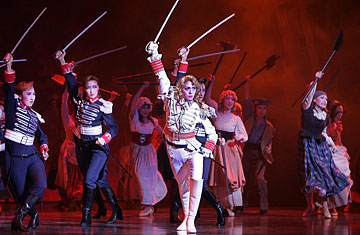
Kei Aran, center, performs during the Takarazuka theater's "The Rose of Versailles" final rehearsal in Tokyo in Februrary 2006
Forty-four young women in wide hakama pants stand on stage at the Takarazuka Grand Theater, a 30-minute train ride west of Osaka. With faces framed by boyish bobs or slicked-back hair, they announce in unison that they are the newest members of the Takarazuka Revue, an all-female musical theater group. And while these women — all graduates of the group's own school — might seem unaffected, their performances are anything but.
Almost all of the 2,550 seats have been sold for the day's matinee. The ensuing spectacle of song and dance looks like it was put together by Las Vegas choreographers and drill instructors from Pyongyang. It's a mix of high kitsch, discipline and idealism, driving home a singular message: love endures. The three-hour show has about 120 actors, begins with a musical play (Raindrops Fall on Roses) and ends with a song-and-dance revue (Amour, It's Something Like ...). The costumes are adorned with enough glitter to make Liberace's eyes water.
Takarazuka actresses — there are about 400 in five troupes — have been leaving audiences speechless with these marvelous and at the same time overwhelming works for 95 years. Founded in the town of the same name — by Ichizo Kobayashi, a locally born railway magnate who thought that lively entertainment would attract more tourists and thus increase rail traffic — the theater group now averages about 10 major productions a year, each with a lead time of about eight months. Faced with shrinking audiences and increased competition from all forms of digital entertainment, its producers are trying to make the shows more dazzling and singular than ever before.
Lest you think that there is something very cute and Japanese about the productions, it should be noted that Takarazuka derives most of its inspiration from foreign sources — vaudeville, Radio City Music Hall and Hollywood musicals. In their stylization, codified roles, transvestite stars, rigid themes (which in Takarazuka's case is almost always boy and girl fall in love, conflict ensues and is resolved) and combinations of dance, drama and chorus, there are obvious similarities between Takarazuka and the traditional Japanese performing arts of Kabuki and Noh theater. But these tales of chaste love are told through adaptations of Broadway plays, Western literature and Korean soaps.
Uniquely, Takarazuka's audience is about 90% female and multigenerational. One producer refers to a "vertical" fan base, with grandmothers, mothers and daughters attending performances. Ten minutes into any production and it's easy to see why women of all ages flock to these romances. They are infatuated with the otokoyaku — female actresses in male roles, playing the part of idealized men to perfection. Gone is the belching, unkempt, groin-scratching oaf of everyday reality; in his place stands an elegant, considerate dandy, ever ready to open doors and produce bouquets. "Not just any man, but more like a man than men," says one senior Takarazuka staffer.
It takes years of training to become a otokoyaku. Some spend a decade crafting how they sit, speak, walk and gesture. But the commitment expected does not deter the hundreds of teenage girls who apply for just 40 available places each year. Many, like top Takarazuka graduate Rei Makoto, start out as fans. While still in high school, Makoto became obsessed with NeoDandyism, a Takarazuka production featuring the troupe's well-known actress Maya Miki. "I rehearsed with the DVD at home all the time," she says, dressed in jeans and a blazer — the staple ensemble of an off-duty otokoyaku.
Keiji Okada, a playwright and composer who has authored many works for Takarazuka, says that the company is about to take a "modern and futuristic" turn. Stage sets will emphasize "sharp, metallic and powerful colors and lines." Sources of inspiration are also widening: one recent production was based on the Capcom video game Phoenix Wright.
Okada says he intends to steer Takarazuka toward more Asian stories, especially Chinese and Korean ones. "Not Christian, but Buddhist. Maybe even John Woo," he says. The mind strains to contemplate a Takarazuka production of something like Woo's historical epic Red Cliff. But you'd be amazed at what can be done with 400 women, gorgeously lit pastel scenery and a ton of glitter.
— with reporting by Yuki Oda
